Don’t miss the rest of our responsible tourism guides:
MADRID | BARCELONA | SAN SEBASTIAN | SEVILLE | LISBON | PARIS
Call us biased, but we think Rome is one of the most beautiful and fascinating cities in the world.
We must not be alone: with some 10 million visitors a year, Rome is the single most popular destination for tourists to Italy and the third most-visited destination in Europe.
But that tourism has come with downsides.
Rome’s total population is just under 3 million; only a small fraction of that number (less than 200,000) live in the centro storico (historic center), where most tourists tend to congregate. Well-meaning visitors overcrowd once-local hangouts, not to mention tourist sights like the Vatican museums (visited by more than 6 million people a year) and Colosseum (more than 7 million).
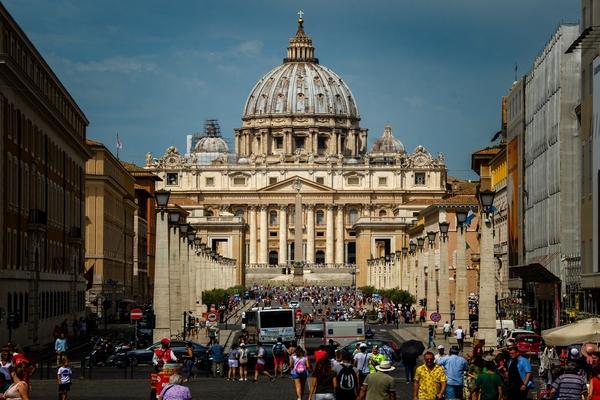
Lovely streets once dotted with unique independent shops have been taken over by stores selling souvenirs and cheap imported clothes and goods.
Finding a reasonably-priced flat to live in, never an easy feat in Rome, has become even more difficult for locals as more owners choose to lease their apartments through sites like Airbnb.
Even Rome’s food culture is changing: the once-beloved Campo dei Fiori food market, for example, now is dominated by souvenir stalls and cheap goods aimed at tourists, while as more restaurants cater to tourists’ tastes, traditions like local cuisine and seasonal produce are getting left behind.
Of course, it’s not all bad. Despite these changes, Rome remains a city unlike any other on earth. But it’s important to note that the reasons that most of us love Rome—its excellent food, its extraordinary sights, its artisanal shops—are the very things that tourism is in danger of destroying. What a shame that would be… for all of us!
Want to make sure your impact on Rome is a positive one? Here are some tips.
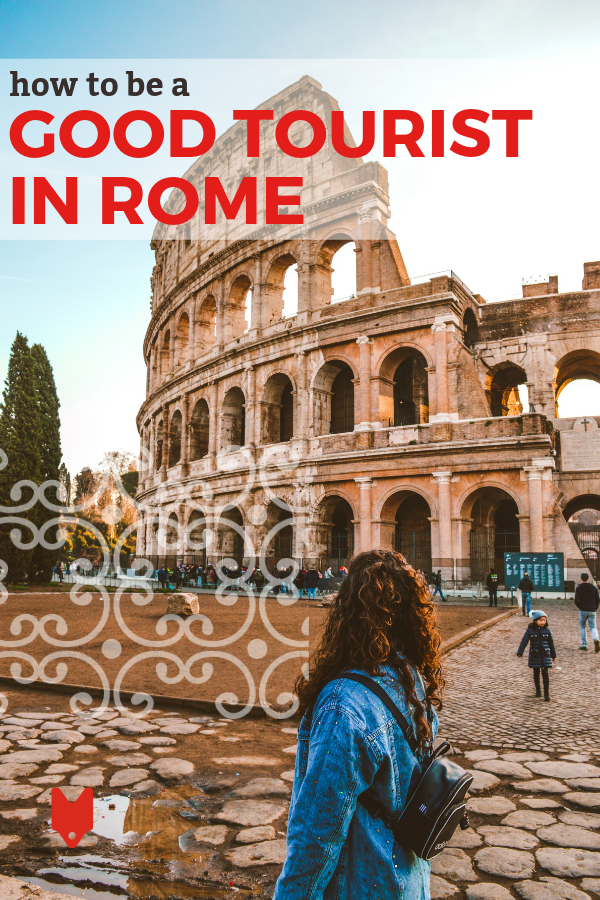
When to visit Rome responsibly
Most of Rome’s visitors come in the summer months. We understand that that’s when many children (and adults, for that matter) get time off. But if you can avoid it, do. In summer, Rome can be uncomfortably hot, flights and hotels are at their most expensive and it’s when the city is most crowded.
If you must come in the summer, at least avoid August and the start of September. This period, known as ferragosto, is when even locals themselves leave. That doesn’t just mean that parts of the city can feel oddly empty and that there’s an even higher tourist-to-local ratio. It also means that small, family-run restaurants and shops—the kinds of businesses that, as a responsible traveler, you’d want to support—are much more likely to be closed.
Your best choice? Come in the off season. Just be clear about when that is. High season kicks off as early as April in Rome, gets into serious high gear in June, July and August, and doesn’t abate until October. Outside of those months, high season also includes other weeks, like Easter and Christmas, when more people are off school and work.
Our favorite months in the city are October and March, when the weather is likely to be mild. But for beating the crowds, spreading out the economic boost of tourism over the year, and not adding to the tourist mayhem of downtown Rome, November, January and February are your best bets.
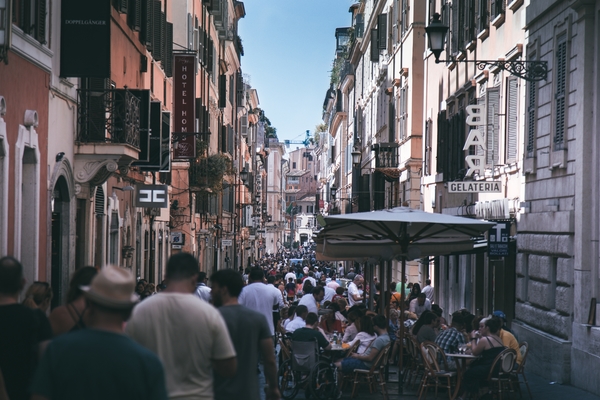
How to get to Rome responsibly
There’s something else to consider, too: your flight.
We don’t like it either, but as the most recent warnings from the world’s leading climate scientists make clear, we can’t stick our heads in the sand any longer: we’re currently on track towards warming by 1.5°C in as little as 11 years, an amount that will have profound changes for the way we all live.
One of the single biggest ways we can all help is by changing the way we fly. A single return flight from New York City to Rome, economy class, emits 1 metric ton of carbon into the atmosphere; that’s the same output as if you burned 1,093 pounds of coal or drove a car 2,445 miles.
Of course, for many visitors, a flight is the only feasible way to get to Rome. But there are still ways to mitigate your impact.
First, fly economy: because they take up more space, business and first class seats gobble up three to even nine times as much carbon as flying coach. Second, fly nonstop: about one-quarter of a flight’s emissions come from takeoff and landing, so even if it costs a little more, it’s much more efficient (not to mention convenient!) to go with a direct flight. Third, avoid traveling in the summer (yes, that again!): planes require more fuel to lift off in the heat. And finally, consider a carbon offset: some airlines let you do this during the booking process, but if not, the UN has a trustworthy list of carbon offset programs that are easy to donate to and surprisingly economical, starting from just $0.50 to offset an entire ton of emissions.
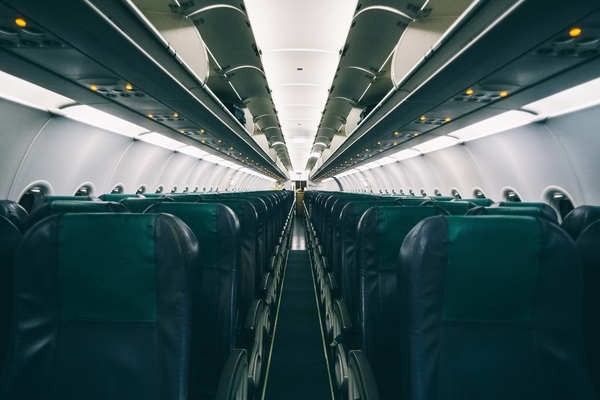
Where to stay in Rome responsibly
Your choice of where to stay has an impact, too.
First, think about the neighborhood. Most tourists congregate in the heart of the historic center, the area around Piazza Navona, the Pantheon and Trevi Fountain. This means that area is especially vulnerable to the downsides of invasive tourism, such as seeing artisans closing down shop, touristic restaurants moving in and locals finding the prices and lack of “normal” amenities (like food stores) untenable.
In a less touristic neighborhood, you won’t just be making a positive impact by spreading out the crowds (and tourist dollars)—you’ll also have an easier time finding better, cheaper meals and more interesting shopping yourself.
Intrigued? Neighborhoods we’d recommend that are central and close to the sights, but relatively off the beaten path, include the Aventine, south of the Circus Maximus; the Forum Boarium, tucked just to the south and west of the Roman forum; and Celio, between the Colosseum and St John Lateran.
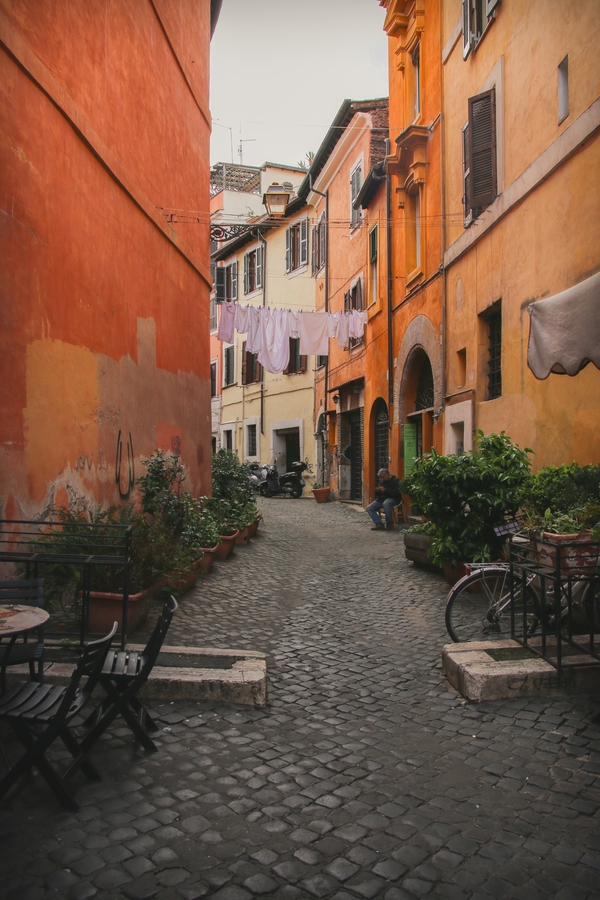
Slightly further afield, check out Testaccio, which also happens to have some of the best restaurants in the city and is just five minutes on the metro or bus from the Colosseum; Parioli, an upmarket neighborhood with a Parisian vibe just north of the Villa Borghese park; and Prati, particularly the part a few blocks north of the Vatican, a lovely residential area with tree-lined streets.
Also think about your type of accommodation. We know that sites like Airbnb can be extremely convenient, but they’ve had a negative impact too.
As many landlords now opt to rent out their places on Airbnb rather than lease to locals, locals are having an even more difficult time finding homes in the center. That means more locals moving out of the center, which means a higher tourist-to-resident ratio, which means even more demand for Airbnb, which means landlords use it even more—the definition of a vicious cycle.
Instead, consider a locally-owned hotel (there are hundreds in Rome) or a B&B. At the very least, if you do use Airbnb, book a flat that someone actually lives in most of the time, whether they’re just renting it out while they’re on holiday or you’re staying in a spare room.
How to eat responsibly in Rome
Our number-one tip for eating responsibly in Rome is also, conveniently, our number-one tip for eating well in Rome. In short? Eat local, in-season food, and avoid the tourist restaurants.

At the very least, that means avoiding the tourist centers (you never want to eat on Piazza Navona, for example). It also means avoiding any place where a friendly host is trying to get you to come inside—we promise, authentic local spots don’t do this. And run, don’t walk, from anywhere that has an all-inclusive tourist menu.
When it comes to eating like a local in Rome, also remember when locals eat. Never look for a place to eat anytime before 8 p.m.: Romans rarely eat before 8 or 8:30 p.m., and 9 p.m. is the most usual time for dinner. The more you can stick to local mealtimes, the less pressure restaurants feel to start changing their own rhythms to cater to tourists—the definition of invasive tourism.
It’s also important to keep in mind that food culture in Italy is highly regional. In Rome, or at least at traditional Roman restaurants, for example, you won’t find risotto (which is associated with Milan and the north) or thick-crust pizza (which you’ll find more in Naples and the south). You also won’t find a number of foods that many of us think are Italian, but are in fact Italian-American or Italian-British—so don’t waste your time looking for “classics” like spaghetti and meatballs, lobster fra’ diavolo or garlic bread.
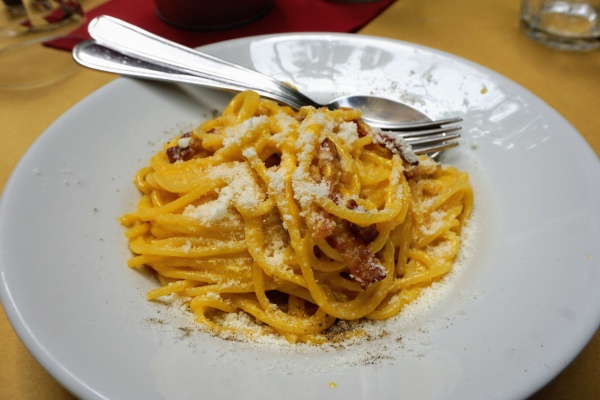
Fortunately, you’ll find plenty of other delicious dishes! Some of our favorites are…
- carciofi: artichokes in Rome usually are cooked alla giudia (fried to a crisp) or alla romana (slow-cooked so they’re buttery and tender). Just remember to only order these when they’re in season, February to May.
- pizza: traditional Roman pizza is thin, crisp, and always baked in a wood oven
- gnocchi alla romana: semolina dumplings, usually only offered at restaurants on Thursdays
- bucatini all’amatriciana: pasta in a sauce of guanciale (pork jowl), tomato, a little red pepper, a bit of wine, and pecorino
- pasta alla gricia: pasta (hopefully handmade!) with pecorino, black pepper, and guanciale
- cacio e pepe: a pasta served with grated pecorino cheese and black pepper
- pasta alla carbonara: a pasta with a creamy sauce that has no cream, it’s made just with diced guanciale, eggs, and either parmesan or pecorino
- saltimbocca alla romana: veal wrapped in prosciutto crudo and sage, then rapidly fried
- coda alla vaccinara: oxtail, slow-cooked until it falls off the bone and usually served in a hearty tomato stew
In the center, we like enjoying these classics at restaurants including Roscioli, Armando al Pantheon, Al Pompiere and for pizza, Li Rioni.
Eating in season is key, too. As Roman artichokes have become popular, for example, tourists are now asking for them year-round. This means artichokes from outside of Italy are being flown in, something which negatively impacts local farmers, agricultural cycles, carbon emissions… the list goes on. Plus, it means you won’t be having as authentic an experience of the dish (and it won’t be as fresh). So make sure to read up on what’s in season when.
Need help? The restaurant Urbana 47 prides itself on using all locally-sourced ingredients. There’s also the Campagna Amica market at Via di San Teodoro, near Circus Maximus, where all of the products (think cheese, olive oil, veggies and more) are sold directly from local producers (Saturdays and Sundays only).
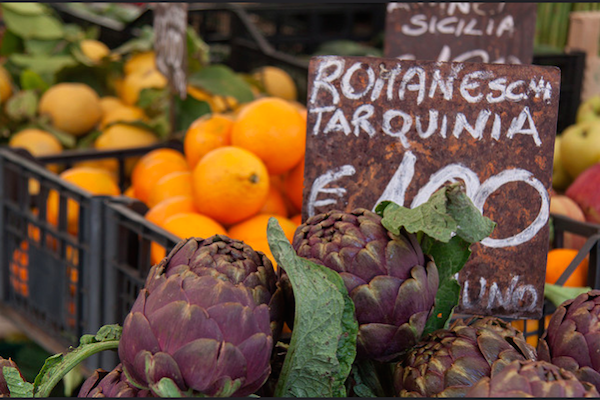
A responsible travel itinerary for Rome
We won’t try to talk you out of seeing major sights like the Colosseum, Pantheon and Sistine Chapel. And we wouldn’t want to—these are unique gems and must-sees for a reason. But to be a responsible traveler (and to get the most rewarding experience out of your visit!) you need to think about how you see them.
First, plan your timing.
No matter what time of year you’re coming, try to visit these sights on their off hours. The Vatican museums and Sistine Chapel, for example, tend to be most crowded from about 10 a.m. to 2 p.m. If you arrive at 2 p.m., you’ll have a much more pleasant, less crowded experience than you would mid-morning. Better yet, take advantage of either the very early-morning or the evening tours that some of the sights now offer (you can visit the Colosseum on Sunday nights, for example).

Second, decide if you want to take a tour before you arrive in Rome.
A tour can be an excellent way to get the most out of a sight. But don’t be tempted to buy a “skip-the-line” tour at the last minute from a shill at the Colosseum or Vatican once you’ve already arrived.
The industry of off-the-street tours is the wild west (complete with criminal involvement and lots of cash changing hands), so while they aren’t all equally bad, it’s better not to feed the beast. Plus, you have no idea how good the tour guide is until you’ve already bought the tour—the friendly, English-speaking “gatherer” who sells it to you isn’t normally your guide. Instead, do consider taking a tour, but one from a legitimate company that you research ahead of time.
Finally, go off the beaten path!
It’s not just a great way to be a responsible traveler, but a great way to get the most out of your experience in Rome, too. The city has hundreds of sights, and the vast majority of them get remarkably few visitors. Some of our favorites include:
- Palazzo Altemps, near Piazza Navona; an extremely underrated, little-visited museum of ancient sculpture set in a Renaissance palace
- Baths of Caracalla, where the remains of 3rd-century baths tower 125 feet above you and once accommodated up to 1,600 people at a time
- Palazzo Massimo, Rome’s main archaeological museum, which holds treasures like ancient mosaics, elaborately-carved sarcophagi and incredibly preserved frescoes taken from some of Rome’s most opulent ancient villas
- Crypta Balbi, possibly the most overlooked national museum in Rome, ideal for history buffs and complete with the ruins of the 2,000-year-old theatre in its basement
- Palazzo Barberini, a stunning art museum in a Renaissance palace with famous pieces including Raphael’s La Fornarina, a copy of Hans Holbein’s famous portrait of King Henry VIII and Caravaggio’s frightening Judith Beheading Holofernes
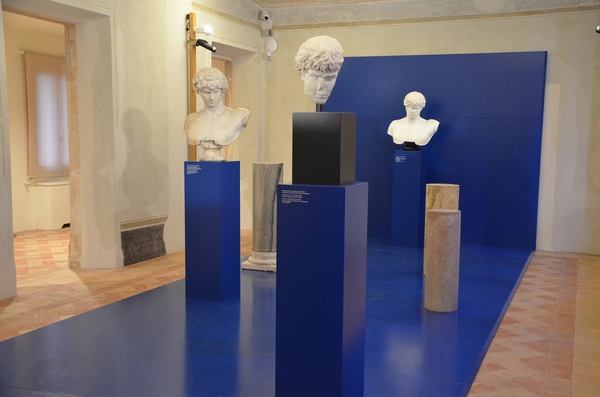
What not to do in Rome
In the last few years, tourists have carved their names into the Colosseum and broken a 500-year-old fountain carved by the famed artist Bernini. Don’t be like them.
But what not to do goes beyond the obvious. Many tourists don’t realize, for example, that they need to remember to not touch or lean on a wall or door threshold when going through the rooms of the Vatican museums—many frescoes now have been all but rubbed away by thousands of people doing the same. Similarly, don’t sit or stand on the tumble-down ruins around the Roman Forum, no matter how inviting they look; some are quite fragile. And never, ever touch any kind of artwork or sculpture.
Be careful taking photographs, too. Make sure your flash and sound are off when photographing local scenes (like a restaurant interior) or ceremonial ones (like a Mass). And make sure your flash is off whenever you’re photographing artwork or tapestries, as the light can be damaging.
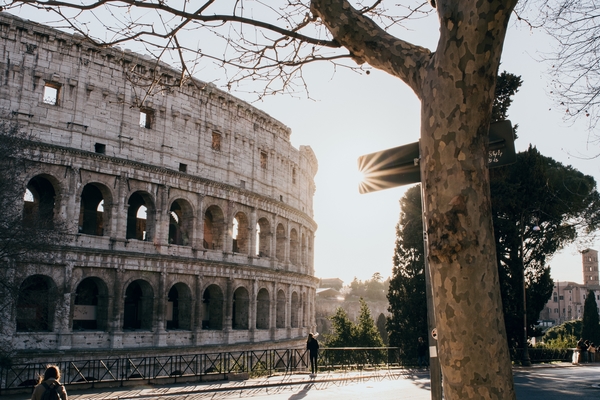
How to shop responsibly in Rome
Rome has excellent shopping, and what makes it that way is that it’s so much more than the chain stores you’d see at any shopping mall in the world.
It’s the independent shops—the individual boutiques, art galleries, “concept stores” and more—that make shopping here so exciting. But my favorite of all are Rome’s artisans. These men and women take the whole idea of having an independent store one step further, actually making the wares themselves (usually in a workshop right there in the store!). The goods you can find handcrafted in Rome run the gamut: glasswares, leather goods, porcelain, mosaic, clothing, jewelry, housewares, shoes, picture frames and textiles are just a few.
Thanks to both globalization and tourism, more and more chain stores are encroaching on these traditions. Whatever you do, please don’t patronize them! That means giving the Via del Corso, which many people think of as a “shopping street,” a miss; these days, it’s just international chains. Instead, check out the artisans and shops on the back streets around Campo dei Fiori, like Via del Pellegrino and Via dei Baullari, or head to the quarter known as Monti, which is full of fascinating and lovely little shops.
The best thing to do, though, is to seek out artisans. (And only trust that something is “artisanal” when you can actually see the workshop in the store). For handmade leather products around Rome, we love Mancini and Pelletteria Nives.
In Monti, meanwhile, some of my favorite artisan’s shops include Ashanti Galleria (a very cool jeweler), Kokoro (a “clothing laboratory”), Tina Sondergaard (handmade women’s clothing) and Studio Silice (a gorgeous glass workshop for plates, vases and more).
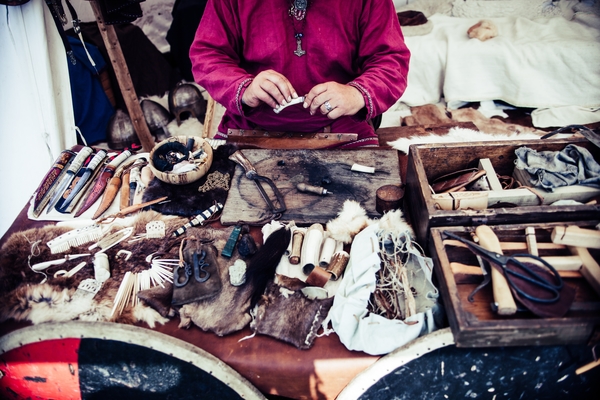
Finally, consider giving back!
If you’ve loved Rome, why not help it in an even more constructive way? Italy is increasingly providing ways for people around the world to become involved in the restoration and upkeep of some of its most treasured sights.
FAI, Italy’s national trust, restores and maintains dozens of sights of cultural and natural heritage across Italy, including castles, gardens and abbeys, and it’s easy to become a patron. Meanwhile, the US-based nonprofit Friends of FAI funds restorations and renovations of cultural heritage across Italy (they’re currently renovating a 15th-century castle!) and takes donations.
Founded in 2014, the nonprofit LoveItaly crowd-funds for a variety of restoration and archaeological projects, communicating where the costs come from and how they’re spent in a clear, transparent way.
The American Institute for Roman Culture increases awareness and campaigns to protect Rome’s cultural heritage. Their specific projects have included petitions to save Hadrian’s villa and the tomb of the gladiator, using social media to teach the world about ancient Rome, and running field excavation schools to inspire new generations of students, classicists and archaeologists.
Follow these tips and you can leave Rome knowing you’ve been a great tourist. Don’t stop there—take a look at the rest of our responsible tourism guides:
MADRID | BARCELONA | SAN SEBASTIAN | SEVILLE | LISBON | PARIS
My wife and I have spent many vacations in Rome over the last 10 years. Most for 3 weeks or more. We have probably spent a total of 6 months in the city. We have progressively moved our time and attention farther and farther from the centre. By slow experience we have adopted almost all your advice , making our visits increasingly pleasant.
So happy to hear you agree, David! It makes for a more pleasant vacation for you, AND it’s better for the city! A win-win 🙂
Makes me think of kakis. They are rotting on trees in Italy but the ones in the shops are the smaller ones from Spain 🙄
Very interesting! Thanks for reading, Kat!